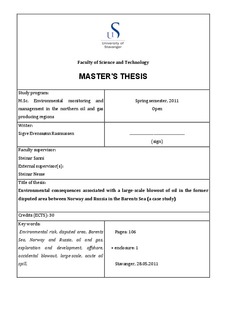| dc.contributor.author | Rasmussen, Sigve Evenssønn | |
| dc.date.accessioned | 2011-10-31T09:17:38Z | |
| dc.date.available | 2011-10-31T09:17:38Z | |
| dc.date.issued | 2011 | |
| dc.identifier.uri | http://hdl.handle.net/11250/182497 | |
| dc.description | Master's thesis in Environmental technology | no_NO |
| dc.description.abstract | The former disputed area between Norway and Russia in the Barents Sea is of increasing interest when it comes to oil and gas exploration and production. The area is likely to open for exploration in the near future as the maritime delimitation and cooperation agreement between Norway and Russia concerning the Barents Sea were ratified by the Russian State Duma and signed by Russian President Dmitri Medvedev during the spring of 2011. The impact of a blowout of oil with a long duration in this area is not well studied, and this thesis strives to describe some of the consequences associated with such an accident. A location was chosen in the disputed area and blowout scenarios were created to give data input to this case study. The location is at 73°N 32.30°E, and the distance from shore is approximately 258 km. A blowout of the order of magnitude as the blowout from the Macondo-prospect in the Gulf of Mexico was an initial point for defining the scenarios. Oil drift has been modelled with OS3D for both weighted scenarios during all four seasons and long-term scenarios of 35 and 100 days. Results from the modelling have been compared to the presence of valued ecosystem components to suggest species and areas that are prone to harm. Results from the oil drift modelling indicate that it is highly unlikely for oil released from this location to hit the shorelines of Norway and Russia, even during scenarios with long duration. This decreases the risk that the oil and gas activity on this location will pose to the environment, as vulnerable areas along the coast of Norway and Russia are left unaffected by the oil on the open ocean. Fish and marine mammals are prone to loss on an individual level, while pelagic seabirds are suggested to be the most vulnerable component due to its presence at the open ocean and the long restitution time of the populations. | no_NO |
| dc.language.iso | eng | no_NO |
| dc.publisher | University of Stavanger, Norway | no_NO |
| dc.relation.ispartofseries | Masteroppgave/UIS-TN-IMN/2011; | |
| dc.subject | teknisk miljøvern | no_NO |
| dc.subject | offshore teknologi | no_NO |
| dc.title | Environmental consequences associated with a large-scale blowout of oil in the former disputed area between Norway and Russia in the Barents Sea (a case study) | no_NO |
| dc.type | Master thesis | no_NO |
| dc.subject.nsi | VDP::Technology: 500::Environmental engineering: 610 | no_NO |
